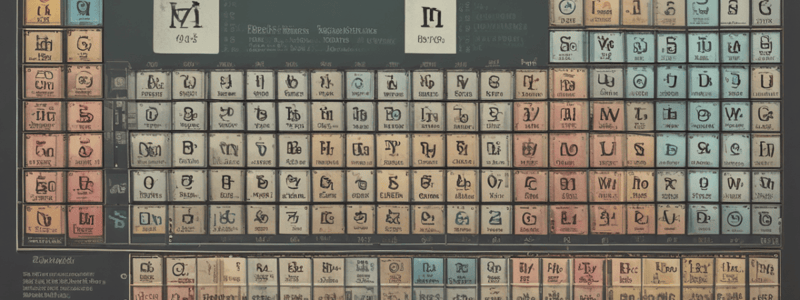Podcast
Questions and Answers
What defines each element?
What defines each element?
- A unique atomic number only
- A unique atomic number and symbol
- A unique name, symbol, and atomic number (correct)
- A unique name and symbol
Where are the non-metals found on the Periodic Table?
Where are the non-metals found on the Periodic Table?
- On the left side of the table
- In a diagonal strip on the right side of the table
- In the middle of the table
- In a triangular region at the top right side of the table (correct)
What is the purpose of the semi-metals?
What is the purpose of the semi-metals?
- To separate the metals from the non-metals (correct)
- To separate the metals from the semi-metals
- To group the metals together
- To group the non-metals together
What are the vertical runs on the Periodic Table called?
What are the vertical runs on the Periodic Table called?
Where are the metalloids found on the Periodic Table?
Where are the metalloids found on the Periodic Table?
What is the term for the horizontal runs on the Periodic Table?
What is the term for the horizontal runs on the Periodic Table?
What is the primary purpose of the Periodic Table?
What is the primary purpose of the Periodic Table?
What information can be found on each tile of the Periodic Table?
What information can be found on each tile of the Periodic Table?
Who is credited with proposing the version of the Periodic Table used today?
Who is credited with proposing the version of the Periodic Table used today?
How are the elements arranged in the Periodic Table?
How are the elements arranged in the Periodic Table?
What is the atomic number of the element in the top lefthand corner of the Periodic Table?
What is the atomic number of the element in the top lefthand corner of the Periodic Table?
What is the name of the Russian scientist who proposed the Periodic Table?
What is the name of the Russian scientist who proposed the Periodic Table?
Flashcards are hidden until you start studying
Study Notes
Introduction to the Periodic Table
- The Periodic Table is a chart that lists all the known elements.
- The table is arranged in a way that elements with similar properties are placed in the same group.
- The version of the Periodic Table used today was first proposed by Dmitri Ivanovich Mendeleev in 1872.
What is on the Periodic Table?
- Each element is represented by a tile that includes:
- Chemical symbol
- Atomic number
- Mass number
- The table is arranged in a way that elements with similar properties are placed in the same group.
How are the Elements Arranged?
- The element with the smallest atomic number (Hydrogen) is in the top left corner of the table.
- Elements are arranged in regions, often presented in different colors.
- Metals, non-metals, and semi-metals are grouped together.
Identifying Elements
- Each element has a unique name, chemical symbol, and atomic number.
- Metals are found on the left of the Periodic Table.
- Non-metals are found in a triangular region at the top right of the table.
- Semi-metals (or metalloids) have metallic and non-metallic properties and are found in a diagonal strip on the right-hand side of the table.
Key Concepts
- Periods are the horizontal rows of the Periodic Table.
- Groups are the vertical columns of the Periodic Table.
- Atomic and mass numbers can be found on each element's tile.
- Being able to interpret group and period numbers is important.
Studying That Suits You
Use AI to generate personalized quizzes and flashcards to suit your learning preferences.




